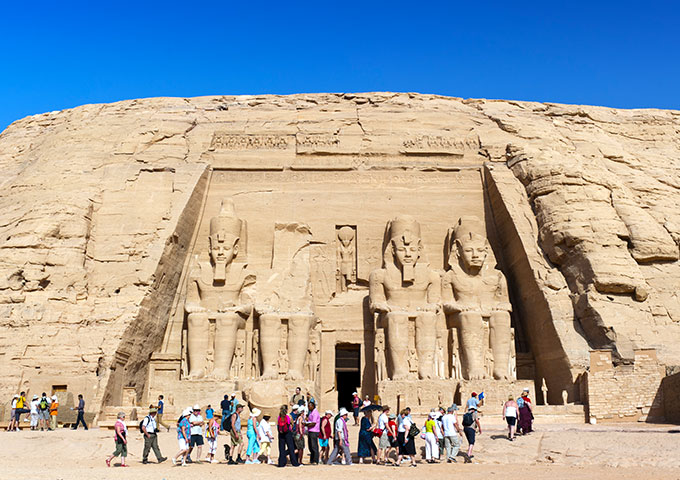This monumental temple complex was built by King Ramses II (c.1279-1213 B.C.E.) in what was once known as ancient Nubia, as a demonstration of both his worldly and divine power. He was the most prolific pharaoh in terms of building works, and a highly accomplished military leader.
In the early 1960s the entire temple complex was moved to higher ground when the Aswan Dam caused Lake Nasser to rise and inundate the area. The two temples were dismantled and raised over 60 meters up the sandstone cliff where they were reassembled, in the exact same relationship to each other and the sun, and covered with an artificial mountain. Most of the joins in the stone have now been filled, but inside the temples it is still possible to see where the blocks were cut.
The Temple of Ramses II
The Temple of Ramses II at Abu Simbel (108 feet high and 125 feet wide) is cut into the face of a sandstone cliff, with its entrance guarded by four colossal (65 feet high) statues of King Ramses II. At the feet of these statues are smaller statues of the Kings children. Above the entranceway in a niche stands a statue of the sun god, a falcon headed representation of Ramses. Inside the entrance way lies the Grand Hall (57 feet high and 52 feet wide), which is supported by 8 columns – with statues of King Ramses II – and has grandiose battle scenes on the walls. To either side of the Grand Hall are two smaller treasury rooms. Beyond the Grand Hall is the Hypostyle Hall containing flowered pillars and scenes of the King and his wife, Nefertari. Finally you reach the inner sanctuary and the statues of Ra, Ramses II, Amun and Ptah seated against the far wall.
Abu Simbel Sun Festival
The temple faces east, and at the solstices – twice a year – the dawn sunlight is aligned to light the entire length of the temple entrance corridor (some 200 feet inside), lighting up three of the four statues at the end of the corridor, but never that of Ptah, the god of darkness. The Solstices’ commemorate Ramses II’s ascension to the throne (22nd February) and his birthday (22nd October).
We have departures on all the tours listed below on the 17th October 2009. These will be in Aswan in time to visit Abu Simbel on the 21st October, when the sun will still shine in through the temple entrance, though not to the same effect. This is a very popular time to visit the temples, and we will need to book the Abu Simbel option a week or so in advance for you to guarantee flights.
The Temple of Hathor
The Temple of Hathor at Abu Simbel was built by Ramesses II to honour both Hathor as the goddess of love and music and his wife Nefertari as the deified queen. The facade resembles a pylon, just as the larger temple of Ramesses II, and the entrance is flanked by six standing colossal (over 33 feet) statues. On each side of the entrance stand two statues of Ramesses flank by one of Nefertari dressed as Hathor. Like at Ramesses II’s temple, there are children depicted around their feet. There are cobras protecting the Temple door.













